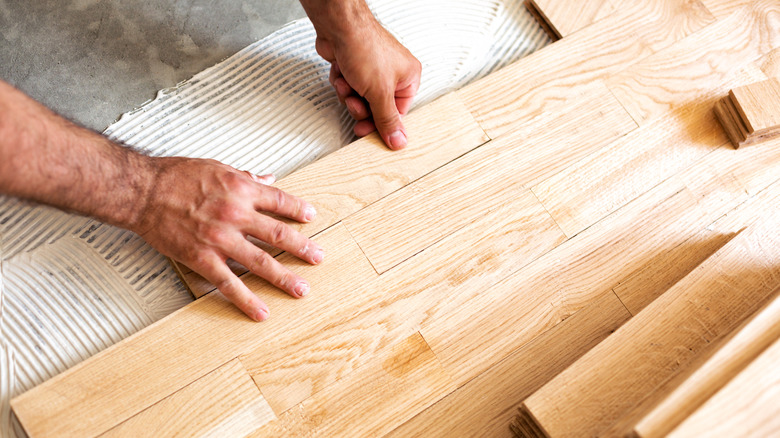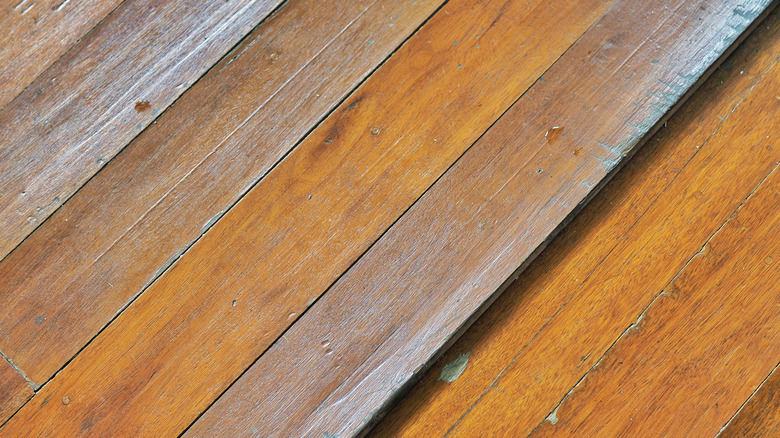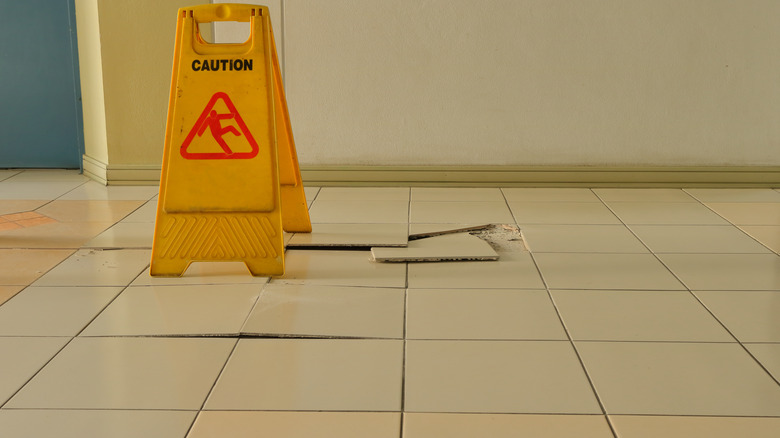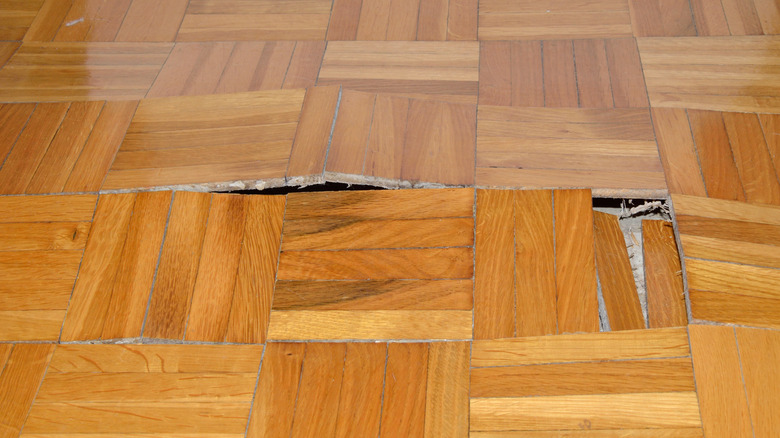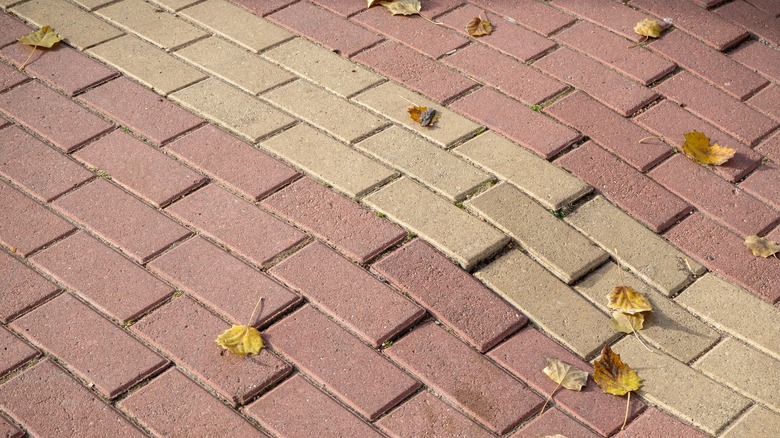5 Signs That Your Home's Subfloor Needs To Be Replaced
Under the regular floor in your house lies intricate structural layers referred to as the subfloor. Because the subfloor is often hidden away from plain sight, it is usually hard for a homeowner to know what is happening. Over the years, subfloor materials have changed, but the most common ones include concrete, plywood, oriented strand board (OSB), and high-performance panels. Typically, well-constructed subfloors are made to last a lifetime, but depending on the installation's quality, some don't get to last as long as the house. Subfloor replacement is not an easy task; in fact, the only time this part of the house gets some action is during major renovations.
According to Fixr, replacing the subfloor costs between $3 and $12 per square foot, depending on the materials, location, and installation technique. Therefore, you need to be sure that your subfloor needs replacement; otherwise, you will incur unnecessary costs for no reason. However, for regular homeowners, figuring out whether the subfloor needs replacement is often easier said than done. Take a look at the following tell-tale signs that should let you know if your current subfloor has outlived its usefulness and needs a replacement.
1. Annoying loud squeaks
Although most floors often have minor squeaks, loud ones should be a cause for concern. Once the squeaking on your floor starts, it is unlikely to stop unless you do something. Subflooring is held to the joist using nails or screws, but for older homes built before the nail gun, driving the nails to the joists was done by hand, so there is always a margin for error. But what has this got to do with a squeaky sound, though? The annoying squeaks happen when the subfloor and the joist separate, leaving some clearance compelling the floor to sink in and out, rubbing against the nails, and causing the noise, via From The Forest.
Usually, this means that the nails no longer hold the floor and joist together, and the subfloor might need replacement. Also, if the subfloor warps, nails holding the joist and the subfloor will become loose. If you can narrow down the specific spot causing the squeak, you can repair that spot without necessarily replacing the entire subfloor. However, if the squeaks happen all over the house or room, you might need to replace the whole subfloor in your home.
2. Musty smell
If you notice a persistent musty smell in your home that won't go away no matter how hard you try, there might be moisture in the subfloor wood. This smell is usually a surefire sign of growing molds and mildew. Water damage is a homeowner's worst nightmare, and the sad part is that it is pretty difficult to isolate where the damage has occurred especially if it has happened beneath the floor. In truth, water damage is the leading cause of subfloor problems, mentions All Dry USA (ADU).
Usually, when dealing with the musty smell, the damage is already done, and you need to address the problem before it snowballs into a bigger issue. In such a scenario, first, you need to identify where the water might be coming from. An excellent place to start is in the bathroom and kitchen area where appliances are likely to leak, for instance, the dishwasher or the refrigerator. You can also inspect the roof for leaks, which are often quite evident.
3. Cracking and popping floor tiles
When tiles are installed right, they often don't pop out or even crack unless under heavy load. While a couple of tiles may break for different reasons, you should be worried if you notice several cracked tiles in your home. Tiles are not flexible, and maintaining minimal deflection is paramount to preventing cracks. When the subfloor is unstable or warps, this often causes some tiles to pop while others crack during the process. Sometimes, the wooden joists under the subfloor might be spaced too far apart, causing deflection on the subfloor.
Another point worth mentioning is that incompatibility between the tiles and the subfloor material will likely cause tiles to pop out randomly around your house. Because of movement and adhesion problems, it is crucial to lay a cement backer board over the subfloor before installing ceramic tiles. It is tough enough to strengthen the subfloor and provides a perfect canvas for proper adhesion, via Tile Fix Direct. Popping and cracking tiles can be caused by a couple of other problems but replacing the subfloor often fixes this issue completely.
4. Cupping hardwood floor
When a hardwood floor is installed well, it is not only a delight to the eyes, but should also provide you with lengthy service. Installing a hardwood floor is quite expensive, and any damage to this pristine floor will also hurt the value of your home. According to Bona, the primary reason hardwood floors curl is moisture problems, especially when the bottom side of the floor is exposed to water. Consequently, since wood is porous, it absorbs moistness and eventually swells, causing the rear ends of the panels to get out of position.
However, it is essential to mention that this problem is not caused exclusively by damage to the subfloor. Sometimes the floorboards were not well installed in the first place, allowing moisture through. Nevertheless, there is always a chance that the subfloor has something to do with your floorboard curling. The easiest way to determine if the subfloor is the main culprit is by checking its moisture level. If the subfloor is dry, then installation might be the issue.
5. Uneven and sunken sections
One of the tell-tale signs that your subfloor might be compromised and need replacement is visibly uneven or sunken spots. The floor in your home should be even with no apparent dips or soft spots; however, if there are specific locations that feel like they can give in at any moment, your subfloor might be weak. Two primary causes for sunken floors are significant water damage on the subfloor or the joists being spread too wide.
As mentioned earlier, when the subfloor is exposed to moisture, it begins to rot, compromising the structural integrity. Unfortunately, you will only know of the damage via a persistent musty smell or when you notice sunken spots on the floor. On the other hand, the wrong spacing of the joists underneath the subfloor might also cause your problem. According to DecksDirect, the ideal spacing should not be any wider than 16 inches in the center. While the size of the lumber also determines the spacing, deviating from the ideal often causes the floor to be uneven and sunken.
